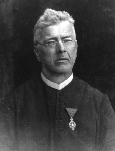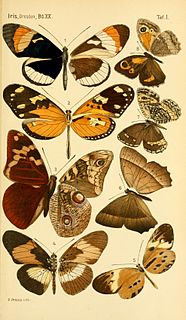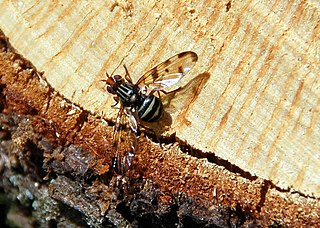
Friedrich Hermann Loew was a German entomologist who specialised in the study of Diptera, an order of insects including flies, mosquitoes, gnats and midges. He described many world species and was the first specialist to work on the Diptera of the United States.
Wilhelm von Winthem (1799–1847) was a naturalist and entomologist from Hamburg, Germany, who was chiefly interested in Diptera and Hymenoptera. Well placed in a port city, von Winthem built a world collection.

Gabriel Strobl was an Austrian Roman Catholic priest and entomologist who specialised in Diptera.

The Neriidae are a family of true flies (Diptera) closely related to the Micropezidae. Some species are known as cactus flies, while others have been called banana stalk flies and the family was earlier treated as subfamily of the Micropezidae which are often called stilt-legged flies. Neriids differ from micropezids in having no significant reduction of the fore legs. Neriids breed in rotting vegetation, such as decaying tree bark or rotting fruit. About 100 species are placed in 19 genera. Neriidae are found mainly in tropical regions, but two North American genera occur, each with one species, and one species of Telostylinus occurs in temperate regions of eastern Australia.

Carl Ludwig Kirschbaum was a German entomologist, Professor of Biology and Museum Director of Museum Wiesbaden. Kirschbaum specialised in Auchenorrhyncha. He wrote Die Cicadinen der Gegend von Wiesbaden und Frankfurt a. M. nebst einer Anzahl neuer oder schwer zu unterscheidender Arten aus anderen Gegenden Europas and many other entomological works.
Nikolay Grigoryevich Erschoff, also Nikolaj Grigor'jevitsch Erschov, Erschow or Yershov was a Russian entomologist mainly interested in Lepidoptera.
Carl Plötz was a German entomologist who specialised in Lepidoptera and in particular Hesperiidae. He was a member of the Entomological Society of Stettin. He wrote

Xylota is a Holarctic genus of hoverflies similar in structure to the related genera Chalcosyrphus and Brachypalpoides. As the larvae are saprophytic they're usually found in rotting wood. The adult flies are generally associated with woodland and woodland edges and can often be seen running over the upper sides of leaves. Unlike other syrphids the adults of many species rarely visit flowers preferring instead to gather pollen from leaf surfaces. There are over 100 described species of which 12 can be found in Europe. Seven species have been recorded in Britain. Identification of species has been difficult and identifiction by photographs is risky.
Baryplegma is a genus of tephritid or fruit flies in the family Tephritidae.

Urophora is a genus of tephritid or fruit flies in the family Tephritidae.
Euaresta bullans is a species of fruit fly in the genus Euaresta of the family Tephritidae.

Chalcosyrphus is a genus of hoverflies in the subfamily Eristalinae. Many species exhibit some degree of mimicry of various sawflies and other hymenopterans and are often brightly coloured or metallic in hue. The adults are similar in structure and behavior to the related genus Xylota but differ in larval morphology. They can be found throughout Europe, Asia, and North America and seem to prefer damper, boggy habitats. The larvae are saproxylic feeders in rotten wood in these habitats.
Julius Moser was a German entomologist who specialised in beetles.

Gustav Weymer (1833–1914) was a German entomologist. He described many new taxa of butterflies from specimens collected by Alphons Stübel in South America.

The Ditomyiidae are a small family of flies (Diptera).They are found worldwide, most species are found in the Australasian and Neotropical realms. There are only two genera in Europe Ditomyia Winnertz, 1846 and Symmerus Walker, 1848 Ditomyia is found in Central Europe Symmerus in Northern Europe Symmerus is endemic to the Palaearctic.

Otitinae is the name of a subfamily of flies in the family Ulidiidae. It was formerly the Otitidae. Like the Ulidiinae, most species are herbivorous or saprophagous. Most species share with the Tephritidae an unusual elongated projection of the anal cell in the wing, but can be differentiated by the smoothly curving subcostal vein. Most are dull gray to shiny brown or black flies with vein R1 setulose or, in a few cases, bare.
Lyroneurus is a genus or subgenus of flies in the family Dolichopodidae. Its rank is not currently certain; it has variously been placed as its own genus or as a subgenus of Diaphorus. More recently, it has been suggested by Pollet et al. (2004) to be a synonym of Chrysotus, but some authors maintain generic rank noting that Chrysotus is possibly paraphyletic.

Ditomyia is a genus of fungus gnats in the family Ditomyiidae.
Sphegina spheginea is a species of hoverfly in the family Syrphidae.
Telostylinus is a genus of flies in the family Neriidae.










